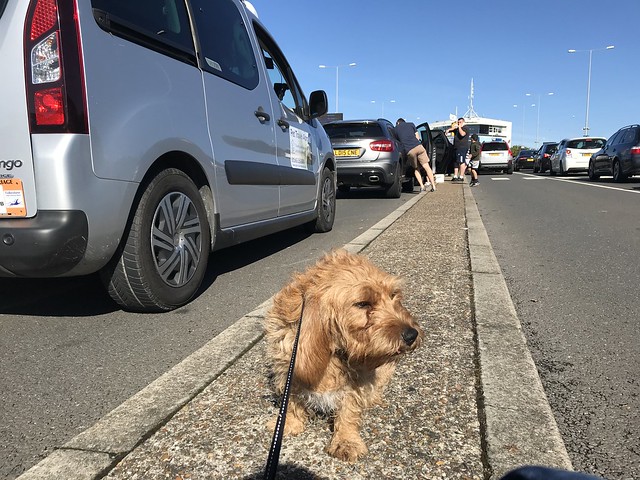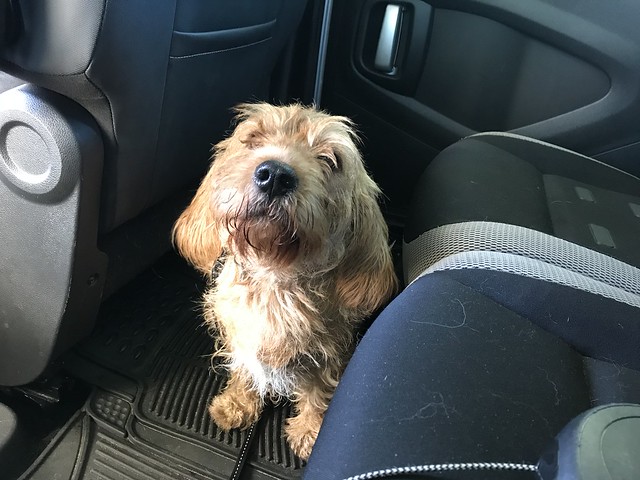Federica Carr continues with her trip to Southern Italy with Amber, her Continental Canine.
Between London and Formia, our ultimate destination, there are roughly 1250 miles, depending on the route considered. By road or rail it is a pretty long way and of course, a plane is the quickest and cheapest way to get there.
But, as we’ve explained before in our introduction, unless your dog is an assistance dog or a very small size, the only way to get there with a pooch is driving or catching a bunch of trains.
The latter option is what we opted for. Across four countries, and hopping on an off six or seven trains, we reached our destination in one piece and without any issues, which is no mean feat.
Here’s what we did.
The UK Leg
We decided to go for the Eurotunnel route, as opposed to the ferry via Hook Van Holland, another dog friendly option. We did not feel like leaving Amber in a crate on a ship, on her own, for a few hours. At least, on the Eurotunnel route, she’d be with us all the way.
With the help of other sites who’ve done it before and piercing together a few customised bits, we finally had the whole route clear (sort of). The whole trip down and back was a puzzle of connecting trains, right down to the very final stop.
It was quite a headache to plan the entire thing, because booking trains with a few different rail companies, in different currencies and time zone can be tricky. I used a helpful and highly usable website called Loco2 to book French and Swiss trains, and then Trenitalia for my Italian trains.
After months of planning, it was time to leave London. Precisely, Elephant & Castle. We had worked ‘backwards’, so decided to set off really early, by Northern Line, to get to our 6.37am fast train from St Pancras to Folkestone.
We arrived at Folkestone West on time; it was a bright and crisp August morning and we walked around the still sleepy residential areas for a bit. There is nothing but houses and green areas so perfect for a pooch, but not ideal for humans.
The cafe kiosk at the station opened around 7am for a much needed coffee (which was surprisingly decent). There are some green areas right outside the station entrance for the convenience of the dog with you; if, like Amber, they only do their business on grass, then it’s perfect.
Crossing the Channel
The next leg of the trip was still on a train, but via a taxi service. Much to the amazement of many friends, there is a local company called Pet Travel Abroad that offers this brilliant service for pet owners: picking them up at a station (or London, for that matter), driving them across the channel and onto any French destination, and back.
Booking was very easy and I could not recommend them more: they were in fact very helpful in putting together the itinerary, advising on London connections and Paris trains too. Frances, our driver, picked us up just after 8, as schedule.
The car was comfortable and, since Frances is a dog owner too, Amber was happily sniffing the seats and the interior of the vehicle. We drove to the terminal and queued for a while, it was in fact quite a busy crossing and we were delayed about 20 minutes on our scheduled train. At this point I was glad I had asked the company to go a train earlier, as I was quite comfortable we had still plenty of time to catch our Calais train.
We did not have time to stop at the terminal, but we’ve been here before: there is a pet area where dogs can walk and stretch their legs as well as make new friends. Inside the terminal there are plenty of shops and cafes however dogs are not allowed in (no idea why!).
Frances does the route so often, she knows everyone! We felt really at ease, and it gave us a sense of security. She dropped us off at Calais Frethun station with about an hour to go and said goodbye, showing us where she’d be picking us up for our return journey.
The UK was behind us! We did not see it again for the next two weeks, until we got back. Frances was punctually waiting for us and ready to take us through the Eurotunnel again.
Back into the UK: Pet Checks
On the way back into England, the border is actually located on French soil (will it change once Brexit is effective?). Before heading through the control however, anyone carrying a pet must stop by the pet check office, just before the check in car lanes.
Having done it a few times, now, we’ve never found it particularly busy and, provided you’ve done your homework correctly, it’s a speedy process. Basically, any UK domiciled pet returning home must show his / her pet passport and medical checks; for non UK domiciled pets, it is a little more complicated, more info on the Government website . For dogs, it means up to date rabies vaccination, and a certification of good health as well as having to take an EU approved wormer (eg Drontal Bayer).
This must be confirmed in writing, dated (with the time!) and stamped by a vet in the passport no less than 24 hours before the crossing and no more than 5 days. It can make the planning tricky and you must make sure the vet actually puts the date and time: the first time we failed to check and we had to drive to Calais to have a local vet verify this over the phone. We wasted ages and learned our lesson!
This time, we were prepared so it took no time. We managed to board an earlier shuttle and arrived at Folkestone West around midday. The cafe was closed and the station was very quiet. Amber took advantage of the English grass again, before we boarded our slow train to London Bridge (takes about 1.40 hours) on a rainy and damp sunday.
A fitting end to our long way down and back!
Follow our Continental Canine adventure for more posts coming soon.

























